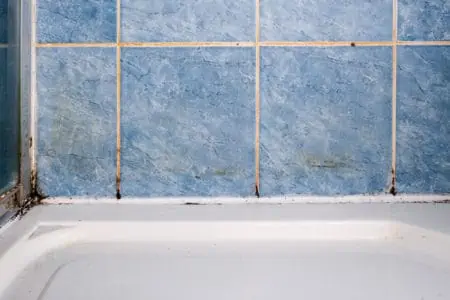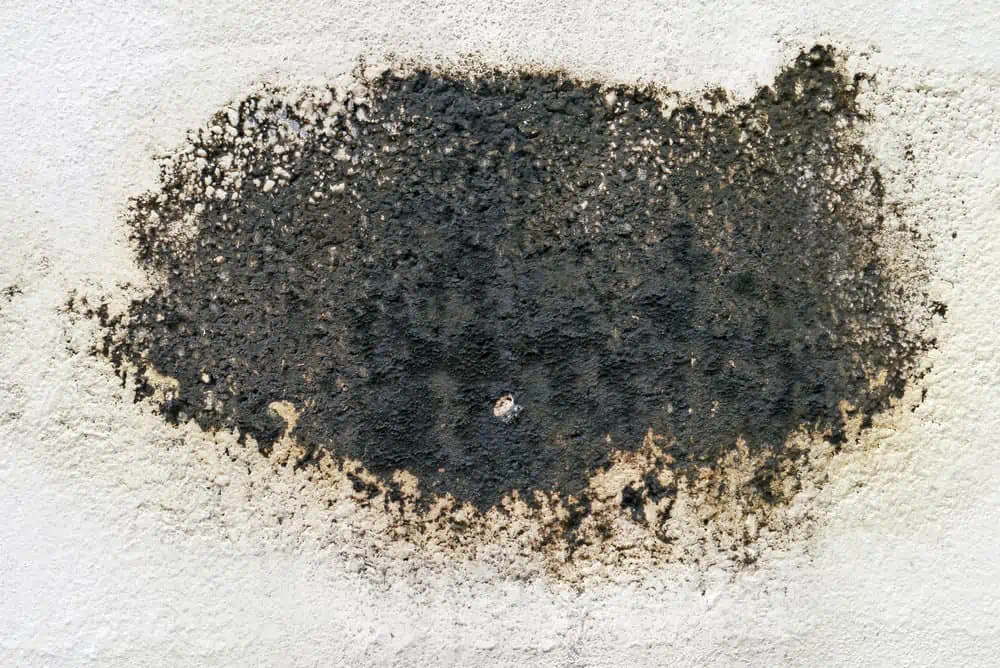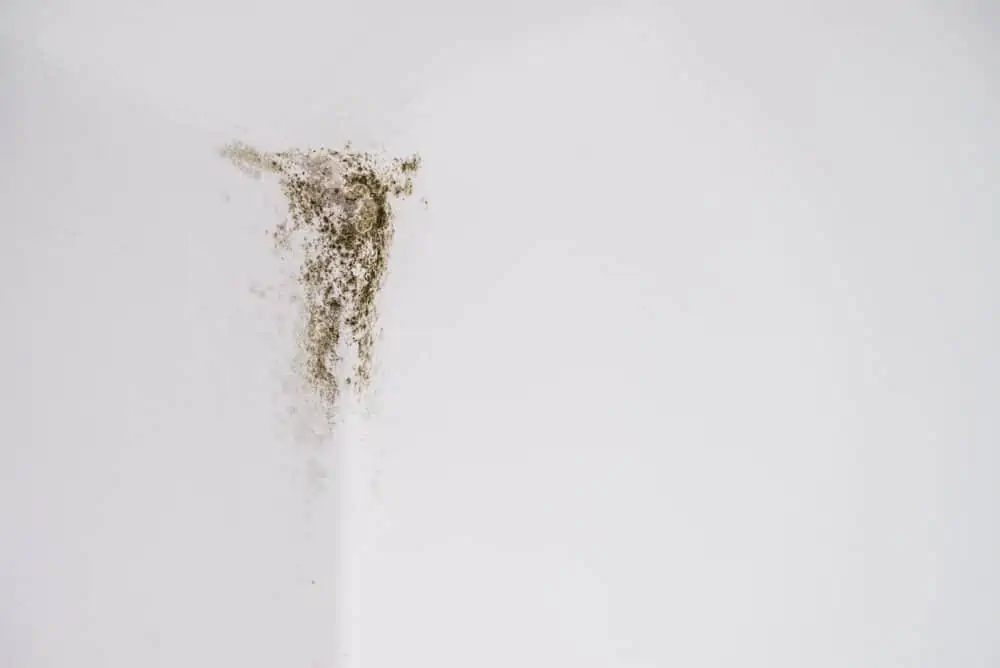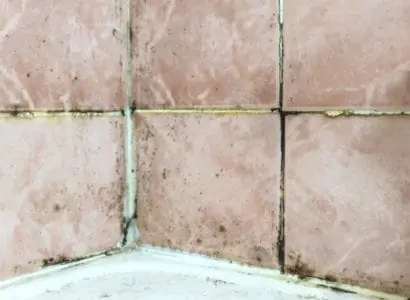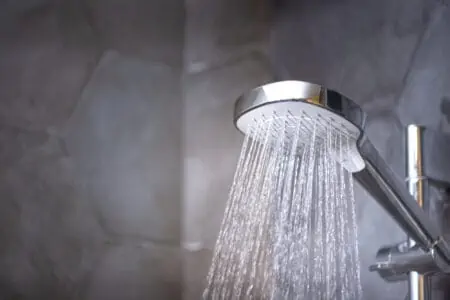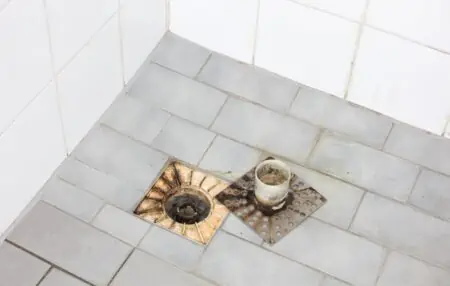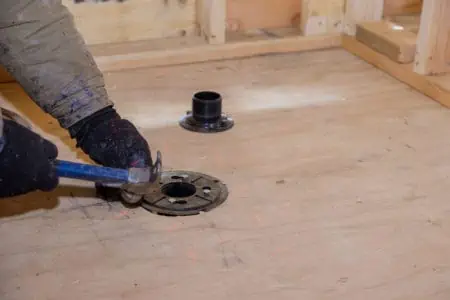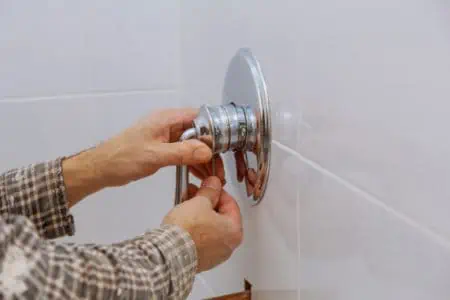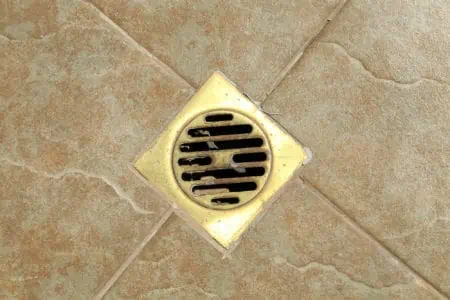Do you have mold stains in the shower but aren’t sure what it takes to get rid of them?
Mold can pose a real health problem, so you should never allow it to get out of control and eliminate it as soon as possible. I’m going to teach you the best way to get rid of mold in the shower but also explain why it’s dangerous.
Key Takeaways
- Make a mixture of one part bleach and two parts water to remove mold.
- Prevent mold growth by keeping your bathroom well-ventilated and dry.
- Regularly clean your shower, tiles, grout, and shower curtain to avoid mold buildup.
- Take safety precautions, like wearing gloves and a mask, when removing mold from the shower.
What Causes Black Mold in the Shower?
Before learning how to clean mold in the shower, let’s see what exactly causes mold in the first place (since prevention is key).
Mold is the result of excess humidity, and there’s not a single room more humid inside the house than our bathroom. Whenever you shower or take a bath, you often leave wet puddles behind.
This creates an environment that favors the apparition of mold. Even the water that evaporates will create humidity in a poorly ventilated bathroom.
To keep growing, mold also needs sustenance. Mold thrives on organic matter, and the more of it there is, the more quickly it spreads.
Mold thrives in homes where dust is a major food supply. Also, whatever body or oil residue you leave behind when showering can also be a food source for mold.
Is Mold in the Shower Dangerous?
As you may already know, shower mold can be just as dangerous as mold found in any other corner of the house. Certain health concerns are associated with breathing in the air in a moldy shower.
If you have a respiratory condition, such as asthma, that increases the risk of health problems. Shower mold could be the culprit if you have a runny nose, a sore throat, or a cough you can’t explain.
Many people seem to confuse black mold and mildew, but a closer look will reveal key differences between the two.
Black Mold
It has a fuzzy or slimy appearance and is dark in color.
Mildew
Mildew has a powdery look and consistency. It’s also dark in color but lighter than black mold.
Relying on smell to tell these two apart is also possible. Mold has a stronger scent, one that feels very pungent. On the other hand, mildew smells musty and has a scent that people often compare to dirty socks.
Best Way to Get Rid of Mold
Those wondering how to remove mold in the shower should know that homemade solutions and store-bought products are available.
Bleach
One of the most common ingredients for cleaning bathroom surfaces is bleach. You can make your own mixture of two parts water and one part bleach.
Put these in a spray bottle and apply them to the affected area. Allow to sit for 10 minutes and rinse. If necessary, repeat the process and use a coarse brush to scrub the mold off.
Baking Soda
Loads of people are familiar with the wonder that is baking soda for cleaning stuff throughout the house. To get rid of mold using baking soda, simply mix baking soda with water to make a DIY paste.
Cover the moldy area with the paste and allow it to do its thing for about 10 minutes. Scrub off the residue with a brush and rinse using warm water and soap.
Vinegar
If you don’t like the smell of bleach or are worried about the potentially toxic chemical fumes, you can always swap bleach with vinegar.
Vinegar allows you to clean mold naturally, and you probably have it around the house already. That means you don’t have to buy anything to get rid of black mold in the shower.
Hydrogen Peroxide
Hydrogen peroxide can effectively get rid of shower mold when used alongside baking soda.
After applying the baking soda paste you made, spray a little hydrogen peroxide on top and watch it fizz. Use a brush to scrub the fizz, rinse, and repeat the process until all the mold is gone.
Ammonia
To get rid of shower mold with ammonia, use products labeled as clear ammonia. Just grab a clean, empty spray bottle.
Make a 50-50 water mixture and ammonia and spray it directly on the mold. Leave the solution for a couple of hours, wipe/scrub, and rinse with clean water.
Borax
For those unfamiliar with the product, borax is a powdery white substance made from boric acid. It’s a natural mineral and can be used to get rid of mold in the shower.
Take a cup of borax and a gallon of warm water, and mix them together. Spray the solution on the affected area, then use a scrub brush to get rid of the mold. Rinse and repeat if necessary.
Magic Eraser
Known as one of the best cleaning products for your home, the Magic Eraser is a sponge infused with cleaning solutions. Plenty of people have used the Magic Eraser to get rid of shower mold, so you can try it too. It’s also effective against mildew.
Bar Keepers Friend
Bar Keepers Friend is another great cleaning solution that helps you fight off nasty mold. You can make a paste, just as you would use ammonia or baking soda.
Mold Remover
Mold removers are specially formulated solutions that help fight mold. Make sure to use a suitable product for grout or bathroom tiles. Always follow the instructions on the label to get rid of mold in the most efficient manner.
Steam
A steam cleaner might do wonders when you have shower mold you want out of sight. It’s a more natural solution to eliminating mold, but it requires investing in a steam cleaner.
A steam cleaner gives off steam at a temperature of over 200 degrees Fahrenheit, which kills mold efficiently. You just have to manually remove as much of the mold as possible before using it.
How to Get Rid of Mold in the Shower
I just want to mention that you can apply a prevention spray to help stop mold in its tracks after each method.
Safety Precautions
Whenever you want to proceed with bathroom mold removal (or any other area for that matter), two safety measures mustn’t be ignored:
- Ventilation is Vital: Always work in a well-ventilated space. Open the door, and windows, turn on fans, or do whatever it takes to ensure airflow.
- Gear Up: Use protective gear, especially rubber gloves and a mask.
Caulking
- Turn on the fan and open the doors before you start cleaning.
- Use one part water and one part ammonia mixture.
- Put it in a spray bottle using a funnel.
- Spray the affected caulk.
- Leave the room for 10 minutes, allowing the solution to sit.
- Take a scrub brush and clean the mold and ammonia solution off the caulk.
- Rinse with warm water and wipe with a clean rag.
- Repeat if you still notice any mold.
Grout
- Make a mixture of half a cup of baking soda with roughly four teaspoons of water.
- Put this paste on top of the grout, wherever you notice mold.
- Leave the paste to rest for 15 minutes.
- Scrub using a sturdy brush.
- Rinse and repeat if required.
Tiles
- Mix two parts of water with one part of bleach inside a clean spray bottle.
- Apply the solution to the moldy tiles.
- Allow the solution to dry.
- Spray some solution again and use a soft brush to clean the tile.
- Rinse and repeat until the mold is completely gone.
Drain
- If you have a shower drain cover, remove it and set it aside.
- Spray hydrogen peroxide on the moldy shower drain, covering the rim, the inside, and the stopper.
- Leave it for five to 10 minutes.
- Take an old toothbrush and scrub the drain thoroughly.
- Rinse, dry, and put the drain cover back in place.
Curtain
- Remove the shower curtain.
- Keep the moldy sides inwards to prevent spreading any spores.
- Take your hydrogen peroxide and a scrub brush.
- Put the shower curtain on a flat surface (you can also do this in the bathtub or on the bathroom floor).
- Use one part water and two parts peroxide mixture.
- Allow the solution to sit for 10 minutes.
- Rinse the solution.
- Whip up a paste using water and baking soda and cover the moldy area.
- Scrub the mold off the shower curtain.
- Rinse and repeat if needed.
- Allow the shower curtain to fully dry before hanging it back.
Important To Keep In Mind
Make sure to also clean the surface where you placed the shower curtain to prevent the spread of spores.
Ceiling
- Use a store-bought mold cleaner to clean the shower ceiling.
- Alternatively, you can also make a solution using dish soap and water.
- After having done either of the two, grab your bleach.
- Mix one quart of water with a quarter cup of bleach. You can also use vinegar instead of bleach.
- Apply the solution to the ceiling using a sponge or spray bottle.
- Be wary of your working position to avoid getting mold or other chemicals on your face.
- Leave for an hour and wipe the area dry.
How to Prevent Mold in the Shower
While mold in the shower might seem inevitable, I want to share a few tips and tricks that could keep it at bay:
- Open the windows after each shower to properly ventilate the room.
- Install a bathroom fan if you don’t have a window.
- Place your shower products on the rack.
- Wipe water whenever you spot it.
- Buy a squeegee and use it on the tiles after each shower.
- Wash your towels often to prevent them from basking in moisture.
- If you use a shower curtain, wash it as often as possible.
- Wash your bath mats regularly and dry them after stepping out of the shower.
- Use your dehumidifier in the bathroom.
- Clean the showerhead as often as possible.
FAQs
Bottom Line
Now that you know how to get rid of mold in the shower, consider what solution best matches your needs. And perform regular cleaning to avoid mold build-up in your shower. The best way to get rid of mold is by helping to prevent it in the first place.
